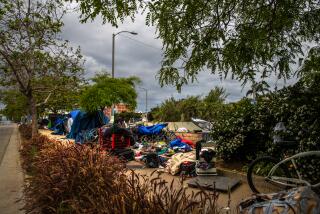Residents Fuming Over Channel Gateway Deal : Development: Builder agrees to drop opposition to shopping mall. Venice activists vow to continue fight.
- Share via
Venice-area activists whom developer Jerome Snyder courted extensively in order to gain approval of the Channel Gateway project are angry at a behind-the-scenes deal Snyder has negotiated that would pave the way for construction of the Marina Place shopping mall nearby.
The private package, designed to head off a legal battle that could tie up both projects for years, has run into a buzz saw of opposition since it became public last week. The two huge projects are planned for sites about half a mile apart near Marina del Rey.
At a community meeting Tuesday night, neighborhood activists vowed to continue their legal efforts to stop the 1-million-square-foot shopping center from being built.
Some of those in attendance made no secret of their displeasure with Snyder for secretly negotiating a deal with Marina Place developers in an effort to protect Channel Gateway from a legal challenge.
“I’m pretty angry at Mr. Snyder for his self-serving actions,” Steve Freeman, a resident of Venice’s Oxford Triangle neighborhood, told the gathering of about 60 neighbors.
Freeman said the $160-million Marina Place project, at the western tip of Culver City, is totally inappropriate for the area. “Our neighborhood cannot handle a regional shopping center,” he said.
He noted the intersection of Lincoln and Washington boulevards, just west of the shopping qcenter site, is “a traffic nightmare now.”
Like other speakers, Freeman urged the audience to support the city of Los Angeles and community groups in their efforts to stop the mall project. “We have to do our best to protect our quality of life,” he said.
Attorney Debra Bowen, one of the founders of a new slow-growth group called the Coast Area Support Team, said later that if Channel Gateway and the Marina Place project are both allowed to go forward, “a lot of people will be very upset.”
The deal that Snyder negotiated with Marina Place developers, Melvin Simon & Associates, would eliminate a six-screen movie theater complex and reduce from 16 to 12 the number of liquor licenses in the mall. Marina Place would also agree to pay for an additional $1.6 million in traffic, transportation and landscaping improvements.
In exchange, Los Angeles would agree to drop its lawsuit against the shopping center, and Culver City would agree to refrain from filing suit to stop Channel Gateway.
Such an agreement would have to be approved by both city councils.
Snyder said in an interview last week that he opened the settlement talks after Los Angeles City Councilwoman Ruth Galanter gave him a number of demands for settling what has become a border battle between the two cities.
But Bowen said she does not believe that the package has a realistic chance of being approved because Galanter has declared it totally unacceptable.
Galanter late last week vowed to kill the deal if it reaches the City Council. She urged both developers to go back to the community and engage in “some honest, open negotiating” if they want to settle the dispute.
Bowen said Snyder has expressed an interest in negotiating directly with community groups when he returns from a European vacation next week. To allow additional time for negotiations, Snyder and Culver City officials have agreed to extend the deadline for filing suit against Channel Gateway until Oct. 1. In the meantime, site preparation work is already in progress on the 16-acre property.
Bowen and other area activists worked closely with the developer after he purchased the land on Lincoln Boulevard from a partnership headed by state Sen. Alan E. Robbins (D-Tarzana). Robbins had originally wanted to build a 2.1-million-square-foot shopping center, office and residential project called Admiralty Place on the site.
Terry Conner, a member of the Coast Area Support Team board, defended Channel Gateway as a “darn sight better” than the Admiralty Place project. He noted that the $400-million project will generate far less traffic because it is primarily residential. And he noted that plans call for 20% of the 544 apartment units in the project to be set aside for affordable housing.
More to Read
Sign up for Essential California
The most important California stories and recommendations in your inbox every morning.
You may occasionally receive promotional content from the Los Angeles Times.













